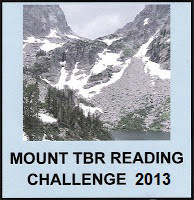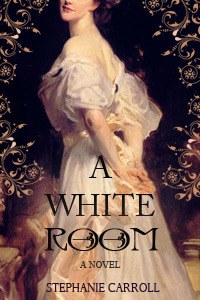Katherine Nabity's Blog, page 221
November 22, 2013
Review ~ The Eight Doctors
Newly-regenerated and travelling through the universe in his TARDIS, the eighth Doctor is suddenly hit by a mind-shattering blast of malignant psychic energy – a final booby trap left by the Master. (via Goodreads)
My entire reading plan for the week went out the window when I decided to skew toward celebrating the 50th anniversary of Doctor Who. After the surprise of “The Night of the Doctor” webisode last week, I again wanted more of the eighth Doctor. The Eight Doctors picks up where the 1996 TV movie leaves off and provides an adventure akin to the 20th anniversary The Five Doctors.
“Let’s just say I’m a Doctor…Clearly, I’m not the one you were expecting.”
The premise is simple. The eighth Doctor must meet his previous incarnations to regain his memories. Of course, the Doctor being the Doctor, there’s always trouble. Some of these visits work considerably better than others. Dicks’ writing shines when describing about Four’s adventures with vampires and the events of The Five Doctors; Raston Warrior Robot included. If there had been more Sontarans, so much the better. In contrast, the political intrigue portion was rather dull and the framing story set in 90s London was somewhat cringe-worthy.
Still, it was fun. Many of the iconic episodes referenced are ones I had just watched or read about in Who’s 50. It’s a nice bridge between big, multi-Doctor adventures, which this weekend’s “The Day of the Doctor” promises to be.
Genre: Sci-Fi
Why did I choose to read this book? Wanted some Doctor Who fun.
Did I finish this book? (If not, why?) Yes. It was a quick read.


November 19, 2013
Review ~ Who’s 50
This book was provided to me by ECW Press via NetGalley in exchange for an honest review.
Who’s 50: The 50 Doctor Who Stories to Watch Before You Die – An Unofficial Companion by Graeme Burk, Robert Smith?
Travel through space and time with this guide to 50 years of Doctor Who
Doctor Who has been a television phenomenon since it began 50 years ago on November 23, 1963. But of all the hundreds of televised stories, which are the ones you must watch? Featuring 50 stories from all eleven Doctors, Who’s 50 is full of behind-the-scenes details, exhilarating moments, connections to Who lore, goofs, interesting trivia and much, much more. Who’s 50 tells the story of this global sensation: its successes, its tribulations and its triumphant return. (via Goodreads)
According to WikiPedia, there have been 239 Doctor Who story arcs aired on television. How do you whittle that down to an essential 50? Graeme Burk and Robert Smith? give it a good try. They do a great job of providing plot and historical context to their choices as well as defending why a particular episode is important to them. Often, they don’t agree and it’s too bad there isn’t a little extra info on their picking process. The best part of At the Movies was Siskel and Ebert hashing out their opinions. I wouldn’t have minded more of that.
Who is this book for? A fan like me. I’m not an encyclopedic fan–much of the trivia and production stories were new to me, but I’m familiar enough with the older story arcs to know what’s going on. I haven’t watched many of the Classic episodes (pre-2005) in years. I took my time with this book because I wanted to watch as many of the chosen episodes as I could. Being of limited means, I didn’t get to them all. If you’re newer fan who has mainly watched the show since its 2005 return but wants to get into the Classic series, I think it’s probably best to watch the episodes before you read about them and to go in order. If you’ve never watched Doctor Who before, this might not be the book for you. It’s not necessarily a list of the *best* episodes, but episodes that are interesting within the narrative of a 50 year old TV show, both in front of the camera and behind the scenes. Who’s 50 is more more the history of the TV show than it is a history of the character.
There’s also some mention of the Doctor Who novels, comics, and audio stories. I know it wasn’t within the purview of the book, but I would have loved a quick list of those essentials as well.
I’m not sure I agree with all the picks (no Donna Noble stories?), but I doubt I could do a better job. It’s fifty years of television gracefully distilled down into a 420+ book.
Genre: Non-fiction, television
Why did I choose to read this book? I’m a Doctor Who fan. And I was particularly interested in what the authors had to say about the Eighth Doctor and the 1996 TV movie.
Did I finish this book? (If not, why?) Yes!
Format: Adobe Digital Edition
Procurement: NetGalley


November 18, 2013
The 2014 Sci-Fi Experience
 Hosted by Carl @ Stainless Steel Droppings
Hosted by Carl @ Stainless Steel Droppings
I would love it if you would consider joining us to read and/or view some science fiction over the next few months. There are no numbers of things you are required to read or view. This is not a challenge, just an opportunity to experience the wonder of science fiction.
For the last two years I’ve wanted to take part in the Sci-Fi Experience, but I’ve always had other books heaped on the TBR pile that weren’t sci-fi. (Not like Readers Imbibing Peril. R.I.P. is easy. I seem to imbibe peril on a regular basis!) Well, it’s that time again, although a little earlier than I expected, and my TBR stack is full of history, Christmas, and Wilke Collins. Perhaps an ill-conceived notion on my part, but I’m proclaiming my participation.
Very tentative list:
 Some Doctor Who fiction. Chirstmas-y Doctor Who fiction. (Almost a certainty. I’m in a Who mood.)
Some Doctor Who fiction. Chirstmas-y Doctor Who fiction. (Almost a certainty. I’m in a Who mood.)The Windup Girl by Paolo Bacigalupi
Infernal Devices by K.W. Jeter
In the Company of Thieves by Kage Baker (maybe)
Whom the Gods Would Destroy by Brian Hodge (maybe)
Something vintage off the shelf. (likely)


It’s Monday! What am I Reading? (11/18/13)
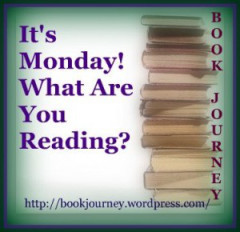 Hosted by Sheila at Book Journey
Hosted by Sheila at Book Journey
It’s Monday! What Are You Reading is where we share what we read this past week, what we hope to read this week…. and anything in between! This is a great way to plan out your reading week and see what others are currently reading as well… you never know where that next “must read” book will come from!
Happy Monday Everyone!
Finished Who’s 50 and worked on The Sons of Moriarty last week, so I didn’t get to either of my bowler-clad book covers. The Pinkerton book will have to wait until until after I finish River City Empire. It’s for research after all.


The 2013 Christmas Spirit Reading Challenge starts Friday with a weekend readathon!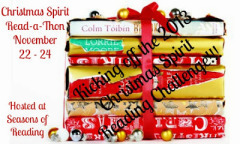
I don’t know how much I’ll be able to -athon on the weekend, but I’m going to try to start in gobliny style:
Hershel and the Hanukkah Goblins by Eric A. Kimmel, Trina Schart Hyman (Illustrator)
The Goblins Christmas by Elizabeth Anderson
Hope everyone has a great week of reading!


November 14, 2013
Review ~ The Invention of Everything Else
It is 1943, and the renowned inventor Nikola Tesla occupies a forbidden room on the 33rd floor of the Hotel New Yorker, stealing electricity. Louisa, a young maid at the hotel determined to befriend him, wins his attention through a shared love of pigeons; with her we hear his tragic and tremendous life story unfold. Meanwhile, Louisa discovers that her father—and her handsome, enigmatic love interest, Arthur Vaughan—are on an unlikely mission to travel back in time and find his beloved late wife. A masterful hybrid of history, biography, and science fiction, The Invention of Everything Else is an absorbing story about love and death and a wonderfully imagined homage to one of history’s most visionary scientists. (via Goodreads)
I.
There are occasions when I read a book and it and life exist a little too close together. When I read Jane Smiley’s A Thousand Acres in college, it was while my family was going through upheaval. That very much affected my experience of that book. Last week, as I was reading The Invention of Everything Else, I was juggling NaNoWriMo aspirations, a high work-load for VOTS, and the development of web pages for Eric’s and my science fiction books. The last on that list was particularly kicking my butt. I know very, very little about JavaScript and JQuery. I was no help to Eric, who knew slightly less than me about JavaScript and JQuery before last week. I’m not a fan of feeling incompetent and ineffective. And the entire project is a gamble–a lot of work for nothing certain. Enter a Nikola Tesla at the end of his life, destitute and imagining talking pigeons. It wasn’t a comfortable read.
II.
Back in September, before I read The Invention of Everything Else, but after I had marked it TBR and purchased Lightning by Jean Echenoz, I took particular notice of an entry at Paleofuture: Making Nikola Tesla a Saint Makes Us All Dumber. The gist, if you don’t click through, is that it’s better to have a realistic notion of a person rather than a mythologized one because it makes them, well, a person. Does working with a character that’s a person (rather than a “character”) make for better fiction? More satisfying fiction?
To the outside observer, Nikola Telsa had a few eccentricities. I have a tendency to view eccentricities in their least exaggerated forms. To me, Tesla sounds like an introvert and probably on the autistic spectrum (as are many of the engineers I know). He was very intelligent, very outspoken in his views, and maybe not the world’s best communicator (…as are many of the engineers I know…). It’s easy to latch on to eccentricities and blow them out of proportion into pure crazy. I found Samantha Hunt’s version of Tesla verging on mentally ill and that seemed extreme to me.
III.
It’s been a while since I’ve read anything-goes literary fiction. I found it tiring. (And again, this might be because last week was one of the most stressful weeks I’ve had in a while.) There were dual narrators (mostly), with Telsa in the first person and Louisa (mostly) in third person. It’s set somewhat in the last days of Tesla’s life as the past and present start, for him, colliding in his mind. For Louisa, the juxtaposition of past and present takes the form of a time machine built by Azor, the balmy friend of her father. Obviously, there are some parallels. Is Azor any crazier than Tesla who claimed to have received transmissions from Mars? To the everyman, should a time machine be any more ridiculous than AC current? The story does veer into the land of speculative fiction when it seems that perhaps Azor’s time machine might have worked. And I don’t know if that magical realism aspect was really needed to give Louisa hope. Maybe I just take too much comfort in science to appreciate magic.
Genre: Historical speculative fiction.
Why did I choose to read this book? I think I came upon someone’s page 99 challenge and thought it sounded interesting.
Did I finish this book? (If not, why?) Yes.
Format: Hardback
Procurement: Tempe Public Library
Bookmark: Checkout receipt.


November 12, 2013
Review ~ Adventures of a Psychic
In this uniquely fascinating book, world-renowned psychic Sylvia Browne recounts her captivating life as a clairvoyant, telling of her earliest “readings” as a young child in Kansas City, and of her first contact with “Francine”, her spirit guide.In engrossing detail, Sylvia tells how her “gift” has assisted police departments in their search for missing children and dangerous criminals — and how her predictions of deaths, plane crashes, and momentous world events were sometimes heeded — or tragically ignored.
But more than anything else, this is the remarkable story of one woman’s psychic odyssey, for it offers illuminating insight into how we can better understand ourselves and our own psychic abilities. (via Goodreads)
Why did I read this book… I have been researching the techniques spirit mediums have used historically and I’m strongly skeptical of Sylvia Browne and her modern colleagues. And I will recuse myself, as I often find myself doing here on my blog: I am not a believer. I did not even try to be objective while reading Ms. Browne’s book. I was curious, I guess, about how a late 20th century psychic presents her history.
The first thing that struck me was the similarity in presentation of Browne’s early history and the semi-fictional biographies of magicians. Some details are over-blown: Browne stating that her ancestors are from a noble Rhine family. Other details are obscured. Dates are few and far between, so some details are hard to pin down. Like the wandering magician, Ms. Browne had an older mentor, in this case her grandmother Ada. She is physically described several times in the book (more than most fictional characters) and is always portrayed as good-looking. Model-esque and doe-eyed. These things are meant to accentuate the positive. They’re a sales job. Even Robert-Houdin knew the value of a good sales job.
Speaking of the positive, Sylvia Browne is never wrong in this book. She might relate times when her talents predict something unfortunate, but she’s never wrong. The book paints herself as completely and uncannily reliable.This is in contrast to a statement made after one of her more recent failures: “Only God is right all the time.” Or maybe it’s her spirit guide Francine who is wrong and, considering what a party the afterlife is, spirits are sometimes too busy to talk.
Francine is also an interesting throwback to mediumistic history. Ms. Browne redubbed her spirit guide with a European name, but like many spirit guides of the Victorian and Edwardian era, Francine is the helpful spirit of a Native American woman.
(Another incredibly co-incidental connection to mediums of old, and something not mentioned in this book, is Sylvia Browne’s criminal conviction involving selling securities in a gold-mining venture under false pretenses. The money solicited from investors was not used for operating costs, but to establish Browne’s psychic research foundation. David Abbott tells of “spirit mine” case in the early 1900s that at least involved a boulder of gold quartz materializing at a seance.)
Much of this book is a presentation of Browne’s religious and philosophical beliefs. Biographical stories are turned into catechism-like Q&A sessions. The afterlife, it seems, is for extroverts, full of parties and discussion groups. Reincarnation exists, as long as you feel the need to work through issues in your next life. There is a God, but he/she is loving and all-knowing, interested in what’s best for us little people. In general, it’s all pretty…general. If I could credit Ms. Browne with anything, it’s devising system of spirituality that is encompassing and tolerant. It seems to be designed to be appealing to a wide range of people. Unfortunately, these very didactic sections make the case-study anecdotes feel vague and glib.
The one area where Ms. Browne shows her warts is her love life. She’s been married or nearly married many times. And I have to wonder, why do so many people follow someone who has made a great hash of her life in this arena? Or, is this weakness calculated? Who hasn’t been foolish in love? Are people inspired because she has seemingly become a success despite these really bad decisions?
I have to be most harsh when Ms. Browne describes the medical applications of her talents. She has no science background and when she mentions something scientific it’s just…wrong. Seven levels of abnormal behavior? The spirit enters through the pituitary gland? Arthritis is described as energy bulging from the joints. Heart attacks are caused by broken-heartedness. In an effort to be scientific during sittings, controls are used to make sure there is no telepathy involved, not to prove that Ms. Browne isn’t using earthly means instead of her clairvoyance. I would find Ms. Browne to be less dangerous if she limited herself to spiritual matters. Leave policing to police and doctoring to doctors.
Genre: Biography/Autobiography
Why did I choose to read this book? Curiosity
Did I finish this book? (If not, why?) Yes.
Format: In-Browser eBook
Procurement: Phoenix Digital Library


November 11, 2013
It’s Monday! What am I Reading? (11/11/13)
 Hosted by Sheila at Book Journey
Hosted by Sheila at Book Journey
It’s Monday! What Are You Reading is where we share what we read this past week, what we hope to read this week…. and anything in between! This is a great way to plan out your reading week and see what others are currently reading as well… you never know where that next “must read” book will come from!
Happy Monday Everyone!
For this week:


Really meant to start on Pinkerton’s Great Detective last week, but The Invention of Everything Else took me a while to get through. Sons of Moriarty is a languishing ARC and River City Empire is, according to Amazon, on its way. (And I still have the rest of the 80s in Who’s 50.)
Next up:
Huh. A hat on every book cover…
Coming up on the blog, reviews of The Invention of Everything Else
by Samantha Hunt and Adventures of a Psychic by Sylvia Browne & Antoinette May. Maybe a Saturday Cinema post.


November 10, 2013
Reading Events – November & December
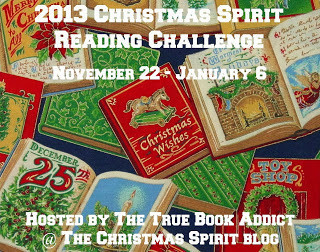 Hosted by the fabulous Michelle at her Christmas Spirit Blog
Hosted by the fabulous Michelle at her Christmas Spirit Blog
These must be Christmas novels, books about Christmas lore, a book of Christmas short stories or poems, books about Christmas crafts, and for the first time…a children’s Christmas books level! Levels:
Candy Cane: read 1 book
Mistletoe: read 2-4 books
Christmas Tree: read 5 or 6 books (this is the fanatic level…LOL!)
Fa La La La Films: watch a bunch or a few Christmas movies…it’s up to you!
Visions of Sugar Plums: read books with your children this season and share what you read
I’m going to shoot for the Mistletoe level because, well, I have good intentions but I’m also fickle. I’ve love the juxtaposition of Christmas and ghost stories, so there will probably be a lot of that. I’m also always interested in exploring other holiday season holidays. I am, I suppose, holiday greedy. I like that so many cultural and religious holidays are clustered during the darkest time of the year. I see no reason why everyone can’t celebrate everything if they so desire. Some of what I might read:








Starting in December
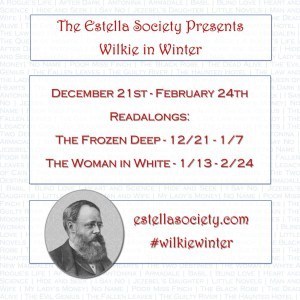 I will finish A Woman in White, I swear it.
I will finish A Woman in White, I swear it.


November 7, 2013
Review ~ A Storm of Swords
Rarely has there been a tale as gripping, or one as likely to seize the minds and hearts of a generation, as George R. R. Martin’s epic high fantasy series. In A Game of Thrones, an ancient kingdom was torn by the ambitions of ruthless men and women; in A Clash of Kings, war, sorcery, and madness swept over the kingdom like a voracious beast of prey. Now, as the brutal struggle for power nears its tumultuous climax, the battered and divided kingdom faces its most terrifying invasion—one that is being spearheaded from beyond the grave… (via Goodreads)
This was a reread for me, but there were large swaths of the book that I didn’t remember. For example, the outcome of most of the weddings had been completely forgotten by me. The event that occurs at the very end, the one that left me utterly gob-smacked the first time I read it, I could have sworn came at the two-thirds mark of the book. (I see this event so vividly in my head that I had to look up whether it’s happened in the show yet. It hasn’t…)
Well, what is there to say about A Storm of Swords? It could be subtitled Four Weddings and a Bunch of Funerals. John and Catelyn annoy me through much of the book. They seem to kvetch about duty a lot, but at least John is incredibly competent at doing what needs to be done, while feeling guilty about it the entire time. (His father’s child, obviously.) Catelyn makes many decisions that involve a great number of people, but that really stand only to serve herself. (That could be where Rob gets it…) Personally, I am left a little heart-broken for Sansa. She is the poster child for this series. All she wanted was to be was a princess; instead, she’s doing her best at managing to be a pawn.
Some of Martin’s plots work better than others. I find the Unsullied to be a fairly ridiculous concept. (Now, if there were a magical aspect to their abilities and control, maybe they would work…) R’hllor on the other hand…interesting. I like A Song of Ice and Fire best when it’s being horror fantasy.
On the whole, I wasn’t itching to read A Feast for Crows until I started writing up this review of A Storm of Swords.
Genre: Fantasy
Why did I choose to read this book? Next in the series.
Did I finish this book? (If not, why?) It took over a year, but yes, I finished the damned thing.
Format: Arm-breaking hardback.
Procurement: Probably Bookmans
Bookmark: My “Go on Adventures” corner marker.


November 5, 2013
Review ~ A White Room
This book was provided to me by Unhinged Books via NetGalley in exchange for an honest review.
A White Room by Stephanie Carroll
At the close of the Victorian Era, society still expected middle-class women to be “the angels of the house,” even as a select few strived to become something more. In this time of change, Emeline Evans dreamed of becoming a nurse. But when her father dies unexpectedly, Emeline sacrifices her ambitions and rescues her family from destitution by marrying John Dorr, a reserved lawyer who can provide for her family.
John moves Emeline to the remote Missouri town of Labellum and into an unusual house where her sorrow and uneasiness edge toward madness. Furniture twists and turns before her eyes, people stare out at her from empty rooms, and the house itself conspires against her. The doctor diagnoses hysteria, but the treatment merely reinforces the house’s grip on her mind.
Emeline only finds solace after pursuing an opportunity to serve the poor as an unlicensed nurse. Yet in order to bring comfort to the needy she must secretly defy her husband, whose employer viciously hunts down and prosecutes unlicensed practitioners. Although women are no longer burned at the stake in 1900, disobedience is a symptom of psychological defect, and hysterical women must be controlled. (via Goodreads)
About two-thirds of the way through The White Room, an argument breaks out at a dinner table. It’s formal dinner table of mixed company, of upper-class Victorian/Edwardians. The argument is about abortions, including abortions with hangers. My patience with this book dissolved along with any semblance of its historical accuracy. If I had been reading a physical copy of this book, I probably would have thrown it against a wall. As is, I was reading on my computer monitor and settled for a face-palm, an eye roll, and a very loud groan of disbelief. (To be clear, I did finish this book, but with band-aid pulling rapidity.)
Stephanie Carroll touches on some interesting issues with her debut novel. Women’s health at the turn of the 20th century is a terrible mish-mash of near-science. Female hysteria was a catch-all diagnosis for many complaints including the male complaint of having an unruly wife. Reproductive health and pregnancies had historically been taken care of by midwives, especially in more rural and poorer areas. Medical science believed it knew better than midwives by the 1900s and I was unaware of the figurative pitched battle that occurred between the two factions.
Unfortunately, these issues are addressed with absolutely no subtlety at all. The expressed attitudes of all the characters in this book are very outspoken and quite modern. At times I felt like characters might break into a discussion about the current healthcare debate.
Granted, our narrator is not reliable. Emeline is pretty unbalanced. I don’t find any ambiguity in the narrative on this count. I also found her incredibly frustrating. While I understand that women often had no say in matters, Emeline makes utterly rash decisions and never ever sees any other way out of a situation. She was a bold enough character to work as an untrained medical volunteer before her marriage and to offer herself up for marriage, but never thinks that maybe she could, after she was married, at some point in the future, still pursue a nursing career.
Lastly, I found the nuts-and-bots of Carroll’s writing lacking. Her word usage was often strange and Emeline’s use of “kind of,” “uh,” and “um” became very annoying. I understand the want to relate “real” dialogue and maybe indicate that Emeline is young and unsure of herself, but this is a heavy-handed way of doing that.
Genre: Literary fiction.
Why did I choose to read this book? I had hoped that the plot was going to be more ambiguous about its main character’s sanity.
Did I finish this book? (If not, why?) I did. I almost did not.
Craft Lessons: Written dialogue is not realistic dialogue.
Format: Kindle eBook and Adobe Digital Edition.
Procurement: NetGalley








